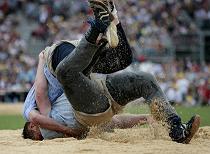|
Schwingen is the Swiss variant
of folk wrestling. It is considered a Swiss national sport.The roots of
Schwingen in Switzerland have not been determined. A picture from the 13th
century (in the Cathedral of Lausanne) shows the typical way of gripping the
opponent. In central Switzerland and in the Swiss plateau, mainly on the
northern rim of the Alps, the Hosenlupf (literally: "trouser lifting") was
common in public festivities. The prize at many alp festivals was a piece of
trouser cloth, a sheep or other natural prizes. |
 |
|
The match takes place in a
ring, a circular area with a diameter of 12 meters that is covered with
sawdust. The two opponents wear short pants made of jute over their clothes.
The wrestlers hold each other by these pants, at the back where the belt
meets, and try to throw the opponent onto his back. There are several main
throws, with names like "kurz", "übersprung" and "wyberhaagge", some of them
very similar to judo techniques - "hüfter" is almost identical to koshi
guruma, "brienzer" is basically uchi mata. These throws are found in many
wrestling systems that have even the slightest emphasis on throwing the
opponent, and can also been seen in shuaijiao. A match is won when the
winner holds the opponent's pants with at least one hand and both the
opponent's shoulders touch the ground. By tradition the winner brushes the
saw dust off the loser's back after the match.
The match is judged by three referees, one of whom stands in the ring. The
referees give points, with a maximum of ten points for a winning throw. If
the match ends without a clear win, the more active Schwinger is awarded the
higher number of points.
At a Schwing festival, every Schwinger wrestles six opponents, or eight at
the Eidgenössische. The two Schwingers with the highest number of points
after five (seven at the Eidgenössische) matches get to the Schlussgang
(last round). The matching of the Schwingers is done by the fight court
according to arcane rules. Often there are suspicions that the matchings
have not been fair, and favor one contestant over the others.
There are no weight classes nor any other categories. Usually, though,
Schwingers are big men, over 180 cm tall and weighing in excess of 100 kg,
and are mostly craftsmen from traditional professions that require some
physical force, like carpenters, butchers, lumberjacks or cheesemakers.
Regional and cantonal Schwing festivals are held outdoors, between early
summer and autumn.
The most important Schwing festival is the Eidgenössisches Schwing- und
Älplerfest, which takes place every three years. The winner of this
tournament is proclaimed Schwingerkönig and receives a bull as his prize. |













